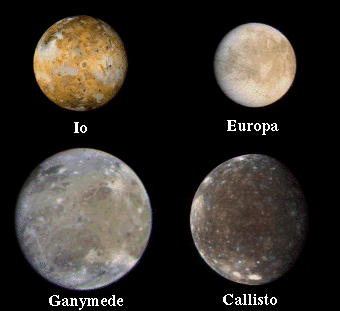The Jovian
Moons
 Jupiter was known to have 16+11 = 27 moons, where the
last 11 were discovered in 2001! see here for details.
Most interesting about the new moons is that a few area actually
retrograde in their orbits---they orbit
opposite to Jupiter's spin. This has implications as
to how they got there. From the site:
"Essentially the only plausible way to produce irregular satellites is by capture. However, it is not
easy for Jupiter (or any other planet) to directly capture passing asteroids from heliocentric orbit. In general, some of the initial
energy of the heliocentric objects must be dissipated so that Jupiter can hold on to them. The origin of the dissipation that lead
to the capture of Jupiter's irregular satellites is unknown. In fact, at the present time there is no plausible source of dissipation
so that capturing satellites is presently almost impossible. It is theorized, however, that the youthful Jupiter sustained a bloated
atmosphere that extended far above the cloud tops of the present planet. Friction with this atmosphere could have captured the
irregular satellites."
Jupiter was known to have 16+11 = 27 moons, where the
last 11 were discovered in 2001! see here for details.
Most interesting about the new moons is that a few area actually
retrograde in their orbits---they orbit
opposite to Jupiter's spin. This has implications as
to how they got there. From the site:
"Essentially the only plausible way to produce irregular satellites is by capture. However, it is not
easy for Jupiter (or any other planet) to directly capture passing asteroids from heliocentric orbit. In general, some of the initial
energy of the heliocentric objects must be dissipated so that Jupiter can hold on to them. The origin of the dissipation that lead
to the capture of Jupiter's irregular satellites is unknown. In fact, at the present time there is no plausible source of dissipation
so that capturing satellites is presently almost impossible. It is theorized, however, that the youthful Jupiter sustained a bloated
atmosphere that extended far above the cloud tops of the present planet. Friction with this atmosphere could have captured the
irregular satellites."
By
far the largest and best known are the 4 Galilean Moons, so named because they
were discovered by Galileo. Indeed, the 4 Galilean
moons are not difficult to see from Earth with even small telescopes.
The adjacent image
(Ref) shows a
Voyager montage of the Galilean moons.
Jupiter's Fancies
The Galilean satellites are all named after objects of mythological Jupiter's
wide-ranging fancies. Callisto was a beautiful maiden who enticed Jupiter,
thereby invoking the wrath of Juno, Jupiter's wife. She turned Callisto into a
bear. After Io's romance with Jupiter, she was turned into a heifer, pursued
by Juno's gadfly. To elude the ever-watchful Juno,
Jupiter approached Europa as a bull; she climbed upon his back, and the two
flew off to Crete, where Europa became an object of worship. Ganymede, a
"handsome youth" attracted Jupiter's attention too, who whisked the boy off to
become a cupbearer to the gods. The stuff of soap opera, right here in your
astronomy class!
Proximity to Jupiter is Destiny
The Galilean moons are all between 3000 and 5000 km in diameter, and they
differ markedly in structure. For most objects in the Solar System we believe
that their mass is the single most important factor governing their
structure. For the Galilean Moons, we will find that the nearness to
Jupiter is the primary determining factor in their structure. Thus, for
most planets and moons in the Solar System mass is destiny, but for the
Galilean satellites proximity to Jupiter is destiny and mass is secondary.
 Jupiter was known to have 16+11 = 27 moons, where the
last 11 were discovered in 2001! see here for details.
Most interesting about the new moons is that a few area actually
retrograde in their orbits---they orbit
opposite to Jupiter's spin. This has implications as
to how they got there. From the site:
"Essentially the only plausible way to produce irregular satellites is by capture. However, it is not
easy for Jupiter (or any other planet) to directly capture passing asteroids from heliocentric orbit. In general, some of the initial
energy of the heliocentric objects must be dissipated so that Jupiter can hold on to them. The origin of the dissipation that lead
to the capture of Jupiter's irregular satellites is unknown. In fact, at the present time there is no plausible source of dissipation
so that capturing satellites is presently almost impossible. It is theorized, however, that the youthful Jupiter sustained a bloated
atmosphere that extended far above the cloud tops of the present planet. Friction with this atmosphere could have captured the
irregular satellites."
Jupiter was known to have 16+11 = 27 moons, where the
last 11 were discovered in 2001! see here for details.
Most interesting about the new moons is that a few area actually
retrograde in their orbits---they orbit
opposite to Jupiter's spin. This has implications as
to how they got there. From the site:
"Essentially the only plausible way to produce irregular satellites is by capture. However, it is not
easy for Jupiter (or any other planet) to directly capture passing asteroids from heliocentric orbit. In general, some of the initial
energy of the heliocentric objects must be dissipated so that Jupiter can hold on to them. The origin of the dissipation that lead
to the capture of Jupiter's irregular satellites is unknown. In fact, at the present time there is no plausible source of dissipation
so that capturing satellites is presently almost impossible. It is theorized, however, that the youthful Jupiter sustained a bloated
atmosphere that extended far above the cloud tops of the present planet. Friction with this atmosphere could have captured the
irregular satellites."